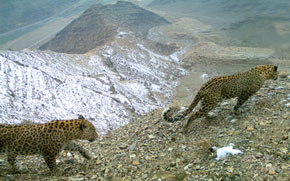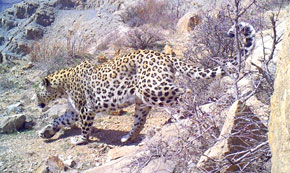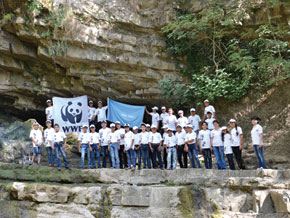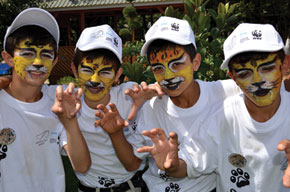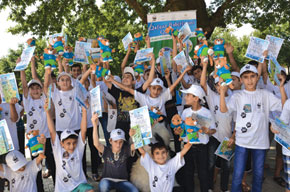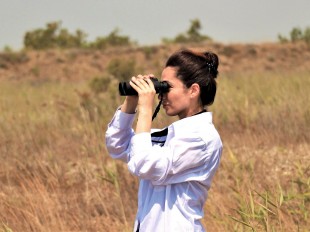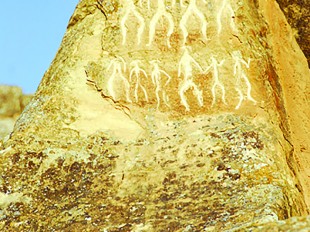These are two fantastic photos for the future of the Caucasus leopard in Azerbaijan, as they show a male and female together. Trap cameras have taken photographs of individual leopards over the past two years, but conservationists say these are the first shots of a breeding pair. The photograph was taken in January by a World Wide Fund for Nature (WWF) trap camera in the Hasan Aliyev Zangezur National Park in Nakhchivan. It is all the more remarkable when you think that less than two years ago, in June 2012, a camera caught the first sighting of a leopard in the area for more than 50 years.
The trap cameras were installed to monitor leopards and their prey as part of a National Action Plan, implemented by the WWF and Ministry of Ecology and Natural Resources of Azerbaijan. The National Action Plan is based on a Regional Strategy on Leopard Conservation developed by the WWF together with the IUCN/SCC Cat Specialist Group.
Seven different leopards have been photographed by trap cameras in Azerbaijan – in the south-western Nakhchivan Autonomous Republic and in the Talish Mountains in the south of the country. In May, the project received a boost when a further 20 cameras were presented to the WWF Baku Office by Leyla Aliyeva, founder of the organisation IDEA (International Dialogue for Environmental Action) and vice-president of the Heydar Aliyev Foundation.
Caucasus Cat Summit
At IDEA’s initiative a Caucasus Cat Summit was held in Baku on 7 May. It brought together acclaimed international experts, including representatives of the WWF, IUCN (International Union for Conservation of Nature), the Smithsonian Institution, Zoological Society of London and the University of Harvard. The summit was co-organised by IDEA in partnership with the Heydar Aliyev Foundation and Heydar Aliyev Centre. Azerbaijan’s First Lady and president of the Heydar Aliyev Foundation, Mehriban Aliyeva, Leyla Aliyeva and Arzu Aliyeva also attended the Cat Summit.
Addressing the meeting, Leyla Aliyeva, said that IDEA worked to protect the environment not only in Azerbaijan, but around the world. She mentioned in particular the following project: The Caucasus Big Five, which seeks to protect five endangered animal species – the brown bear, Imperial eagle, grey wolf, gazelle and Caucasian leopard – is of special significance.
Panthera
Shortly after the summit, IDEA signed a memorandum of understanding with Panthera, the world’s only specialist wild cat conservation organisation. In the MOU, Panthera and IDEA have made a commitment to assess the state and range of Azerbaijan’s leopards and to develop conservation plans for the big cats. The WWF’s National Action Plan comes to an end this year, so maybe together they will draw up a plan for the next five years. Panthera will also assist in training Azerbaijan’s scientists in research and conservation methodologies focused on saving the Caucasus leopard.
Commenting on the agreement, Leyla Aliyeva said: We are delighted to have entered into this strategic co-operation agreement with Panthera, the world's leading wild cat conservation organisation. Panthera has the expertise we need to carry out our programme of preserving the Caucasus leopard and its eco-system, an especially iconic symbol of Azerbaijan's cultural and natural heritage.
Panthera Chairman Dr Thomas Kaplan commented: We welcome Azerbaijan's initiative in seeking to protect and expand its leopard population. Having just launched the conservation world's first global programme for leopard conservation, Project Pardus, we look forward to working with IDEA to make our shared ambition of saving this iconic species become a reality.
The 20 trap cameras presented by IDEA to the WWF were among the first fruits of this agreement.
Leopard numbers
The Caucasus, Persian or West Asian leopard, as it’s also known (Panthera pardus saxicolor), used to be widespread throughout the Caucasus. Numbers fell dramatically in the 20th century, largely because of hunting, persecution, trapping and poisoning. By the 1950s and 60s leopards had disappeared from large parts of the eco-region and, with the exception of Iran, their former territorial range had been reduced to isolated patches.
Classified as ‘Endangered’ by the IUCN, the Caucasus leopard was thought to number around 1,000 in 2008, most of them in Iran but some as far east as Afghanistan. WWF conservationists today estimate that about 50 leopards remain in the wider Caucasus itself, an area that encompasses the whole of Georgia, Azerbaijan and Armenia and some parts of Russia, Iran and Turkey. The WWF say there are about 15 leopards in Azerbaijan, including in the occupied areas – Nagorno-Karabakh and the seven surrounding districts.
Habitat
A lack of prey species was at one time considered the greatest threat to the survival of the leopard. Happily, conservationists now think numbers of prey such as wild (bezoar) goat, wild boar and roe deer are sufficient. At present the two major threats to the leopard’s survival are the fragmentation of its habitat, meaning that potential mates are kept apart, and poaching.
Since the Action Plan was approved in 2009, the size of protected areas in leopard habitats has more than quadrupled, the WWF reports. The organisation’s WWF Caucasus Programme Office is concentrating its efforts on reconnecting leopard habitat by providing wildlife corridors. The Fund has set the mid-term goal of ensuring that at least two wildlife corridors are established and well managed in Hirkan (Hyrcan) National Park in the south of Azerbaijan and the Akhar-Bakhar section of Ilisu Reserve in the north of the country by 2016.
Poaching
Raising awareness of the endangered status of the leopard is an important component in preventing poaching. As part of a public information campaign a summer camp with the slogan “Let’s Protect Leopards!” was held in July for children from the southern Masalli, Jalilabad and Yardimli districts. The camp was the initiative of IDEA and the WWF and was supported by the Heydar Aliyev Centre and Ministry of Education.
The first of these camps was held in 2013 for children from Astara, Lankaran and Lerik districts.
Cubs?
Summer is a relatively quiet time for the Caucasus leopard. As there is increased human activity, with shepherds grazing their animals closer to the leopard ranges, the big cats tend to be less active. Conservationists are hoping for more trap camera pictures in the autumn, including of leopard cubs.
